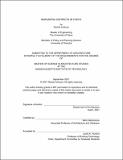Mokumitsu Districts in Tokyo
Author(s)
Ichikura, Ryuhei
DownloadThesis PDF (67.82Mb)
Advisor
Mazereeuw, Miho
Terms of use
Metadata
Show full item recordAbstract
Mokumitsu is a feature of urban districts in Japan and means “densely built-up with wooden structured buildings”. Many of these buildings are categorized as substandard housing because they were built legally in the last century but no longer fulfill the latest building codes. Mokumitsu districts are considered severely unsafe in case of an earthquake because the houses are structurally weak, combustible, and built very close each other. Especially since the disastrous Kobe Earthquake in 1995, Tokyo’s Mokumitsu districts in particular become one of the most serious issues for the nation, due to the districts’ large area and the high probability of earthquake.
Urban renewal—or the demolition and reconstruction of so-called susbstandard housing— is one of the fundamental measures for disaster mitigation in Mokumitsu districts. It is also significant for the existing residents to keep living in the same community after the renewal, in terms of disaster preparedness. However, the current policies for the Tokyo’s Mokumitsu districts are not sufficient to facilitate this renewal. The subsidy for the developers hardly incentivizes design for the residents. Even with the direct subsidy for the residents, they face difficulties to rebuild their own houses that they would prefer on the small individual lands that would become even smaller and thinner after the road widening in the renewal.
Accelerating the renewal in the Tokyo’s Mokumitsu districts by housing cooperative, this research aims to understand what kind of design preferences the residents have, how renewal by housing cooperative can grasp them, and if it is financially feasible and scalable. The author conducted on-site interviews with the residents to ask their design preferences, tested the design of the renewal, and analyzed the financial feasibility from the perspective of real estate.
Date issued
2021-09Department
Massachusetts Institute of Technology. Department of ArchitecturePublisher
Massachusetts Institute of Technology